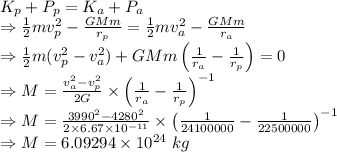
Physics, 21.11.2019 06:31 elishaheart21
Asatellite orbits the earth in an elliptical orbit. at perigee its distance from the center of the earth is 22500 km and its speed is 4280 m/s. at apogee its distance from the center of the earth is 24100 km and its speed is 3990 m/s. using this information calculate the mass of the earth. explain how you arrived to your answer. i have an exam coming up.

Answers: 3


Another question on Physics

Physics, 21.06.2019 21:20
An artificial satellite circles the earth in a circular orbit at a location where the acceleration due to gravity is 6.03 m/s^2. determine the orbital period of the satellite.
Answers: 3

Physics, 22.06.2019 00:20
2.22/3.33 points | previous answers tamucolphysmechl1 4.pre.002. ask your teacher my notes question part points submissions used on a frictionless air track, a blue glider with mass 0.200 kg is moving to the right with a speed of 8.00 m/s. it strikes a red glider that has mass 0.600 kg and that is initially at rest. after the collision, the blue glider is moving to the left with a speed of 2.40 m/s. (a) what are the magnitude and direction of the velocity of the red glider after the collision? magnitude 3.33 m/s correct: your answer is correct. direction correct: your answer is correct. (b) is this collision elastic?
Answers: 1

Physics, 22.06.2019 04:30
You are traveling in a car going at a constant speed of 100km/h down a long, straight highway. you pass another car going in the same direction which is traveling at a constant speed of 80km/h. as measured from your car's reference frame this other car is traveling at −20km/h. what is the acceleration of your car as measured from the other car's reference frame? what is the acceleration of the other car as measured from your car's reference frame?
Answers: 2

Physics, 22.06.2019 07:30
Some material consisting of a collection of microscopic objects is kept at a high temperature. a photon detector capable of detecting photon energies from infrared through ultraviolet observes photons emitted with energies of 0.3 ev, 0.5 ev, 0.8 ev, 2.0ev, 2.5ev, and 2.8ev. these are the only photon energies observed. (a) draw and label a possible energy-level diagram for one of the microscopic objects, which has four bound states. on the diagram, indicate the transitions corresponding to the emitted photons. explain briefly. (b) would a spring–mass model be a good model for these microscopic objects? why or why not? (c) the material is now cooled down to a very low temperature, and the photon detector stops detecting photon emissions. next, a beam of light with a continuous range of energies from infrared through ultraviolet shines on the material, and the photon detector observes the beam of light after it passes through the material. what photon energies in this beam of light are observed to be significantly reduced in intensity (“dark absorption lines”)? explain briefly.
Answers: 3
You know the right answer?
Asatellite orbits the earth in an elliptical orbit. at perigee its distance from the center of the e...
Questions


English, 20.08.2019 07:10




English, 20.08.2019 07:10

Health, 20.08.2019 07:10



Mathematics, 20.08.2019 07:10




History, 20.08.2019 07:10

Mathematics, 20.08.2019 07:10

Biology, 20.08.2019 07:10

Advanced Placement (AP), 20.08.2019 07:10


Mathematics, 20.08.2019 07:10

Mathematics, 20.08.2019 07:10


 = Perigee speed = 4280 m/s
= Perigee speed = 4280 m/s = Apogee speed = 3990 m/s
= Apogee speed = 3990 m/s = Perigee Distance = 22500000 m
= Perigee Distance = 22500000 m = Apogee Distance = 24100000 m
= Apogee Distance = 24100000 m


